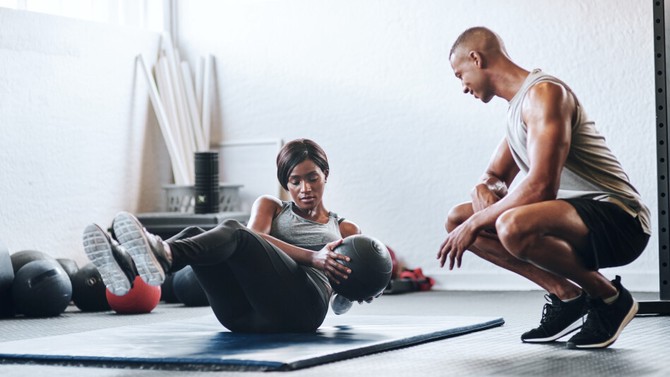4 Common Mistakes Women Make at the Gym
Whether it's because of the way we're built, the way we've been raised or some other reason, we tend to fall into these exercise traps. Here's what to watch out for.
By Corrie Pikul

Photo: Vera Vita/Getty Images
Getting Too Attached to Weight Machines
The mistake: You favor machines over free weights.
The issue: "Functional fitness" exercises that mimic the moves we do every day strengthen the muscles used most often and help us avoid injury. Weight machines, on the other hand, usually focus on one muscle group at a time, and they don't replicate the way we move in the course of our daily lives, says Vonda Wright, MD, a Pittsburgh-based orthopedic surgeon who specializes in injury prevention and mobility.
They're not a the most efficient way to build muscle—for example, you'd use three different machines (leg press, back extension, overhead press) to work the same areas you would with one total-body dumbbell move (squat and overhead press), and you could still get injured. What's more, these machines are usually designed to fit men's bodies, which tend to have a longer limbs and an extended reach.
The fix: For maximum efficiency, try total-body exercises that involve squatting, bending, lunging and reaching. Wright suggests cardio-strength moves like walking lunges with a weight ball, squat jumps and wood-choppers. Or alternate your machine workouts with boot camp classes that focus on strength-building moves.

Photo: martin-dm/Getty Images
Jumping Like a Girl
The mistake: When doing squat jumps or box jumps (hopping up and down with both feet on platforms of various heights), you try not to land too heavily or too hard.
The issue: When you're jumping down from any height, you increase the force and pressure on your joints, so the way you land becomes crucial in preventing injury, says Wright. Men, she says, instinctively seem to get it: They land with their butt sticking out and their knees both facing forward and deeply bent, which absorbs impact. Women, she's noticed, tend to land with their legs straighter and their knees closer together, which can be hard on the joints (it could even cause a ruptured ACL).
The fix: Wright recommends starting with standing broad jumps (where you swing your arms and jump forward with both feet) until you perfect your form and are able to land without wobbling. Increase the height very gradually, and consider stepping down to the ground instead of jumping.

Photo: Westend61/Getty Images
Staring at a Concrete Wall
The mistake: Instead of watching yourself in the mirror, you like to zone out as you race through sets.
The issue: With the rise of the super-minimalist, industrial-chic—or just industrial—gyms, mirrors can be hard to find. Even in gyms where mirrors line every wall, some people find them distracting, so they don't use them. A mirror, though, can be a great way to keep an eye on your form, says Wright, and can help you make sure you're doing an exercise correctly 100 percent of the time.
The fix: Use the mirror, especially when you're doing technical moves like power cleans, deadlifts or even squats (so basic, yet so easy to do incorrectly).

Photo: Drazen Zigic/Getty Images
Over-Resting Between Sets
The mistake: You use your time in between sets to scroll on social media.
The issue: Fitness pro Bob Greene often sees women hanging out between sets at his boot camps and the gym, which, he says, can really undermine their workouts. Socializing on the phone gives your muscles too much time to recover—you need them slightly fatigued in order to build strength.
The fix: Instead of taking a break, Greene suggests taking a brief "pause" that lasts for just 15 to 30 seconds. "Any more than that and you'll lose the benefit you gained from the previous set," he says.

Photo: kupicoo/Getty Images
Wanting to Impress Your Trainer
The mistake: You don't want to admit when you're pooped or in pain.
The issue: When you're tired or unfocused, you compromise your form, and that's when injuries happen, says Jessica Matthews, an exercise physiologist for the American Council on Exercise. Just one sloppy rep, especially when holding heavy weights, can cause you pain or discomfort for weeks. Over time, pushing yourself too hard—or letting someone else push you—can lead to serious overuse injuries (like in this woman's case).
The fix: Tell your trainer as soon as you feel dizziness or pain (even soreness can be a problem if it's affecting your form) or if you're seriously dragging. You trainer won't hold it against you—in fact, it's in his best interest to keep you healthy, safe and active.
Want more stories like this delivered straight to your inbox? Sign up for one or more of OWN's free newsletters!
Published 04/18/2024
As a reminder, always consult your doctor for medical advice and treatment before starting any program.

